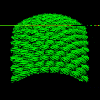 (184K, 577x476)
(184K, 577x476)
 (68K, 374x345)
(68K, 374x345)
 (181K, 577x476
(181K, 577x476
Modeling and rendering of textile fabrics with curved macrostructure is done with ray tracing by using object instancing and tracing curved rays through object space. The more general situation of a curved macrostructure requires the usage of a computational as well as of a physical space. Physical space contains the original piece of textile whose macrostructrue is defined as a free-form surface. Computational space on the other hand contains the corresponding undistorted basic elements. Processing of data is much easier in computational space than in physical space although transformations between physical and computational space are now required. The transformation between physical space and computational space is given as piecewise linear (affine) transformation. Instead of tracing linear rays in physical space (which contains the distorted piece of fabric) curved rays are traced in computational space (which contains the basic elements defined as regular rectilinear grids).
Some examples of ray tracing with curved rays
 (184K, 577x476)
(184K, 577x476)
 (68K, 374x345)
(68K, 374x345)
 (181K, 577x476
(181K, 577x476
In the following example a knitting pattern was texture mapped onto a textile whose drape was simulated by particle systems. Drape simulation with particles is another project done at WSI-GRIS (University of Tübingen)
This page is maintained by Eduard Gröller. It was last updated on November 20, 1998.
If you have any comments, please send a message to edi@cg.tuwien.ac.at.